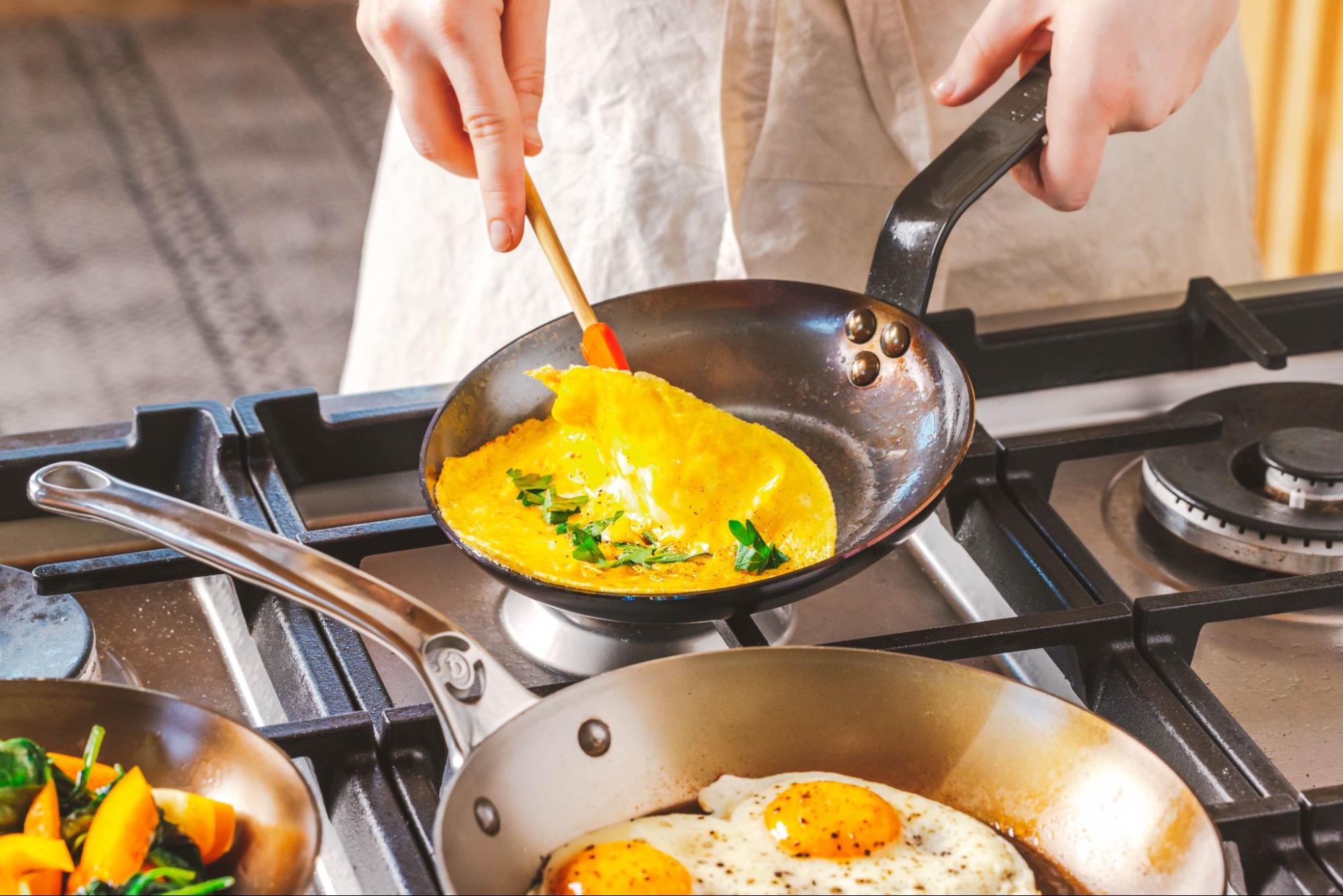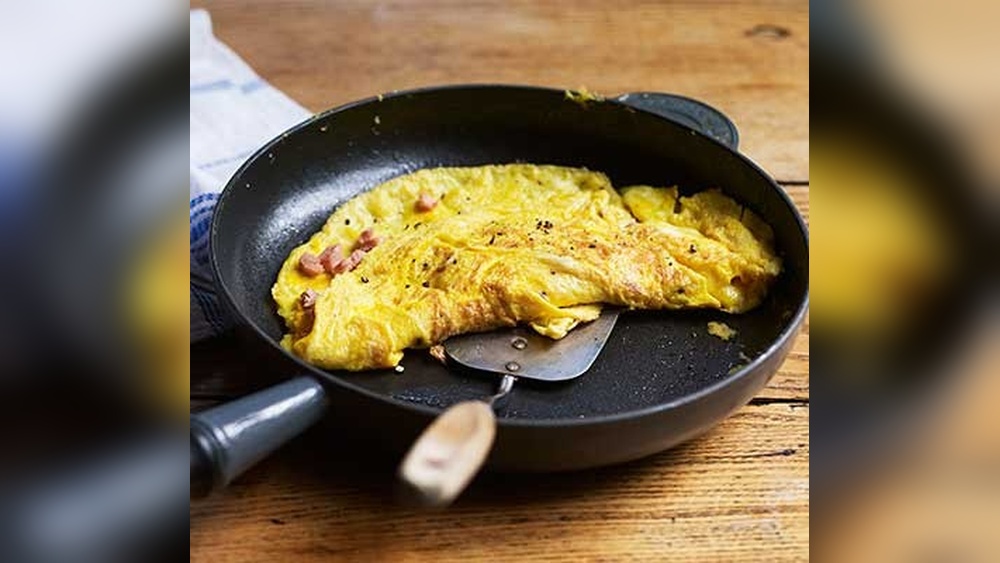You want to make a delicious omelette right in your own kitchen, but maybe you’re unsure where to start. What if you could whip up a fluffy, tasty omelette using just a simple frying pan and a few basic ingredients?
Imagine impressing yourself and others with a perfect breakfast or quick meal that feels both homemade and special. This guide will show you exactly how to make an omelette in a frying pan, step by step, so you can enjoy a satisfying dish every time.
Ready to master this easy skill and boost your cooking confidence? Let’s get started!
Ingredients Needed
To make a delicious omelette in a frying pan, gathering the right ingredients is essential. Each component plays a role in texture and flavor. Simple ingredients create a classic, tasty dish. Below, find the key ingredients needed to prepare your omelette.
Eggs And Dairy Options
Start with fresh eggs. They form the base of your omelette. Use two or three eggs per serving for a good size. Dairy adds creaminess and softness. Common choices include milk, cream, or half-and-half. Add a small splash to the eggs before whisking. This step makes the omelette tender and fluffy.
Butter And Oils
Butter gives the omelette a rich flavor and helps prevent sticking. Use about one tablespoon of butter in your pan. Oils like olive oil or sunflower oil are alternatives. They offer a lighter taste and high heat tolerance. Choose based on your flavor preference and cooking style.
Fillings And Seasonings
Fillings add texture and taste to your omelette. Popular options include cheese, diced vegetables, ham, or mushrooms. Fresh herbs like parsley or chives brighten the flavor. Season simply with salt and black pepper. Keep seasoning light to let the eggs shine.
Choosing The Right Pan
Choosing the right pan is key to making a perfect omelette. The pan affects how evenly the eggs cook and how easy it is to flip or fold the omelette. A good pan helps prevent sticking and makes cooking more enjoyable. Understanding the types and sizes of pans helps you pick the best one for your needs.
Non-stick Vs Stainless Steel
Non-stick pans are great for omelettes. They stop eggs from sticking and need less oil. This makes cooking and cleaning easier. Stainless steel pans heat evenly but can cause eggs to stick. They need more oil or butter to cook well. If you like a crispy edge on your omelette, stainless steel is a good choice. For beginners, non-stick pans are safer and simpler.
Pan Size And Shape
Choose a pan that is 8 to 10 inches wide. This size holds enough eggs for one or two servings. A round pan is best because it shapes the omelette nicely. Avoid pans that are too big or too small. A small pan makes thick omelettes, while a large one makes thin, flat omelettes. The sides of the pan should be low and gently sloped. This helps to slide the omelette out easily.
Preparing The Eggs
Preparing the eggs is a key step for a fluffy omelette. The way you beat the eggs affects texture and taste. Simple methods help create the perfect base.
Small changes, like adding water or milk, can make a big difference. These additions change how the eggs cook and feel in your mouth.
Beating Techniques
Crack the eggs into a bowl. Use a fork or whisk to beat them. Beat until the yolks and whites mix fully. The mixture should be smooth with no streaks.
Beat faster for more air. More air makes the omelette lighter. Beat gently for a denser texture. Use circular or side-to-side motions.
Adding Water Or Milk
Add a tablespoon of water for every two eggs. Water creates steam during cooking. Steam makes the omelette fluffy and soft.
Avoid using too much milk. Milk can make eggs watery or rubbery. Water blends better with eggs for a light result. Try small amounts first to see what you like.
Heating The Pan
Heating the pan is a key step in making a perfect omelette. The right temperature ensures the eggs cook evenly without sticking. Too hot, and the eggs burn. Too cool, and they stay runny. Preparing the pan properly sets the stage for a smooth cooking process.
Optimal Temperature
Heat your frying pan over medium heat. This temperature lets the eggs cook gently. It avoids burning while giving the omelette a soft texture. Test the heat by flicking a drop of water in the pan. If it sizzles and evaporates quickly, the pan is ready.
Butter And Oil Combination
Use a mix of butter and oil for the best results. Butter adds flavor and richness. Oil raises the smoke point to prevent burning. Add a small amount of oil first, then melt the butter in it. This blend keeps the pan slick and tasty for cooking your omelette.
Cooking The Omelette
Cooking the omelette is the key step to get a soft and tasty dish. The eggs must cook evenly without burning or sticking to the pan. Careful attention during this stage creates the perfect texture and flavor. Use medium heat and a good non-stick frying pan for best results.
Pouring And Setting
Pour the beaten eggs gently into the hot pan. The eggs will spread and start to set at the edges first. Let the eggs cook without stirring. This helps the base firm up while the top stays soft. Tilt the pan to spread uncooked egg to the edges. This ensures even cooking and a smooth surface.
Avoiding Overcooking
Watch the color and texture closely. The omelette should stay pale yellow and slightly moist on top. Overcooking causes dryness and browning. When the edges lift easily and the top is just set, it is ready to fold. Remove the pan from heat at this point to keep the omelette tender. A quick flip or fold finishes the cooking without drying it out.

Credit: kristineskitchenblog.com
Adding Fillings
Adding fillings to your omelette brings extra flavor and texture. It turns a simple dish into a satisfying meal. Choosing the right time to add fillings ensures they cook perfectly. The fillings should be warm or cooked before adding. Raw vegetables or meats need pre-cooking to avoid sogginess or undercooking.
Timing For Add-ins
Pour the beaten eggs into the hot pan. Let the eggs set slightly but remain soft on top. Add fillings when the eggs are mostly cooked but still a bit runny. This helps the fillings stick and blend with the eggs. Cover the pan briefly to heat the fillings evenly. Avoid adding fillings too early to prevent watery eggs.
Popular Filling Ideas
Cheese is a classic choice that melts well. Try cheddar, mozzarella, or feta for different tastes. Vegetables like spinach, bell peppers, and mushrooms add color and nutrients. Cook them lightly to remove moisture. Ham, bacon, or sausage provide a savory punch. Fresh herbs like parsley or chives brighten the flavor. Mix and match fillings to create your perfect omelette.
Folding And Serving
Folding and serving your omelette properly enhances its texture and presentation. A well-folded omelette looks neat and keeps the fillings inside. Serving it on a clean plate makes it more inviting. Both steps are simple but important to enjoy your meal fully.
Techniques For Fluffy Fold
Use a spatula to gently lift one edge of the omelette. Fold it carefully over the other half. Avoid pressing too hard to keep the air inside. A light fold helps maintain fluffiness. If the omelette is too runny, fold slowly to avoid breaking. Practice makes perfect with this delicate move.
Plating Tips
Choose a clean, simple plate to highlight the omelette. Slide the omelette gently onto the plate. Add a sprinkle of fresh herbs or a pinch of pepper for color. Serve immediately while warm for best taste. A neat plate with a fluffy omelette looks very appetizing.

Credit: www.debuyer-usa.com
Troubleshooting Tips
Troubleshooting common problems can improve your omelette cooking skills. Small mistakes affect texture and taste. Use these tips to fix issues and cook better omelettes.
Fixing Overcooked Or Undercooked Omelettes
Overcooked omelettes turn dry and tough. Lower the heat and cook slower next time. Add a splash of milk or water to eggs for softness.
Undercooked omelettes are runny and hard to fold. Cook a little longer on low heat. Cover the pan with a lid to trap heat and finish cooking evenly.
Preventing Sticking
Sticking ruins the omelette shape and makes flipping hard. Use a non-stick frying pan or well-seasoned cast iron skillet.
Heat the pan before adding butter or oil. Let the butter melt fully and coat the surface. Pour in eggs only after the fat is hot but not smoking.

Credit: www.bbcgoodfood.com
Frequently Asked Questions
How To Do An Omelette In A Pan?
Heat butter or oil in a non-stick pan on medium heat. Beat eggs, pour into pan. Cook until edges set. Add fillings, fold omelette, and serve hot.
How To Make An Omelette Step By Step?
Crack eggs into a bowl and whisk. Heat butter in a pan. Pour eggs, cook until edges set. Add fillings, fold omelette. Serve immediately.
Do You Put Oil In The Pan Before Making An Omelette?
Yes, add a small amount of oil, butter, or ghee to the pan before making an omelette. It prevents sticking.
Do I Add Water Or Milk To An Omelette?
Add a small amount of water to make your omelette fluffier. Avoid milk, as it can make it tough or watery. Water’s steam helps the omelette rise and stay light.
Conclusion
Making an omelette in a frying pan is simple and quick. Use fresh eggs and a little oil or butter for best results. Pour the beaten eggs gently into the pan and cook on low heat. Add your favorite fillings and fold carefully.
Serve warm for a tasty meal anytime. Practice makes perfect—try different ingredients and enjoy the process. Cooking omelettes can be fun and rewarding for everyone. Now, you have the basics to make a delicious omelette at home.

